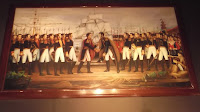The relationship between the U.S. and Ecuador have weakened some under the current administration under the leadership of the left-leaning president Rafael Correa, who has criticized U.S. oil companies operating in Ecuador, the U.S. military base on the coast of Ecuador, the U.S. attempts to prevent Ecuador from offering asylum to WikiLeaks creator Julian Assange, the U.S. war on drugs, and the U.S. banks that help fund the Ecuadorian media. (http://rt.com/usa/news/correa-assange-us-latin-318/). “I love and admire the American people a great deal. Believe me, the last thing I’d be is anti-American. However, i will always call a spade a spade,” Correa told Assange during a recent episode of the his television program on RT. “And if there are international US policies that are detrimental to our country, or even to that of Latin America, I will denounce them strongly. And I will never, ever allow my country’s sovereignty to be affected by them.”
Asylum is defined as:
a refuge granted an alien by a sovereign state on its own territory; a temporary refuge granted political offenders, especially in a foreign embassy
Guayaquil, like most large cities in Latin America, has a large disparity between the rich and poor and a notorious history of violence and robberies. The Ecuadorian government has invested large amounts of money in developing and securing the Malecon (meaning 'pier') area, the city's historic waterfront with a heavy police presence. Many foreign travelers only pass through Guayaquil on their way to or from coastal beach towns, and few stay more than one night. I of course heard many stories about "the friend of a friend" who was robbed in Guayquil, and to avoid the city at all costs. Out of curiosity, I opted to stay for 4 days and see for myself what the city had to offer (and carry very little cash around with me just in case).
What I found was a city not really accostomed to foreigners, but a beautiful city that is enjoyed by its residents and visiting Ecuadorians. Guayaquil is viewed, especially by Ecuadorians from Quito, as lacking history and culture, but from what I found, most of this can be attributed mostly the "Great Fire" of 1896 that destroyed most of the city's colonial architecture. Guayaquil was a very important city for the colonizing Spanish for exporting goods and shipbuilding. It was also often targeted by pirates who plagued the Pacific coast during the development of Ecuador. The Las Penas neighborhood and Santa Ana Hill that overlook the city and the Guayas River are still covered in stone forts and cannons used by the Spanish to protect themselves from pirate attacks. Guayaquil is also historically famous for being the meeting place of the two leaders of the South American Revolution movements, Simon Bolivar and Jose de San Martin, who met and held a conference to both celebrate and set the guidelines for the newly independent nations of South America. A famous statue in the Malecon marks this famous event in South American history. Guayaquil, not coincidentally, was also the starting point of the famous conquistador Francisco Pizarro for his conquest of Peru and the Incan civilization. A proper setting for reclaiming the colonial lands, but ironically all of those who reclaimed these lands came from Spanish or mixed heritage. The indigenous peoples, similar to the history of North America, had very little reclamation.
The city has a very significant history and I learned alot about the area and how it differed greatly from the interior or Andean history of Ecudaor that I was most familiar with. I only spent 4 days, but I did pack in as many activities as possible. Including watching the local professional football team, Barcelona, play a game at what I thought was a restaurant/sports bar across the street from my hotel, but may very well have been a brothel. I left as soon as the game ended to avoid the change in atmosphere from "gametime" to "gaaaametime", but the locals definitely got a kick having a random gringo to watch the game with. Gringo is a much debated term, but today is very common in Latin America and has lost some of the deragotary connotation it once had. I mistakingly (like many others) thought it orginated in Latin American countries wanting the U.S. military out of occupied areas, and would infamously say "Green go home" in reference their green uniforms. Apparently this explanation is somewhat of a an urban myth.
Gringo is defined as:
Word History: In Latin America the word gringo is an offensive term for a foreigner, particularly an American or English person. But the word existed in Spanish before this particular sense came into being. In fact, gringo may be an alteration of the wordgriego, the Spanish development of Latin Graecus, "Greek." Griego first meant "Greek, Grecian," as an adjective and "Greek, Greek language," as a noun. The saying "It's Greek to me" exists in Spanish, as it does in English, and helps us understand whygriego came to mean "unintelligible language" and perhaps, by further extension of this idea, "stranger, that is, one who speaks a foreign language." The altered form gringo lost touch with Greek but has the senses "unintelligible language," "foreigner, especially an English person," and in Latin America, "North American or Britisher." Its first recorded English use (1849) is in John Woodhouse Audubon's Western Journal: "We were hooted and shouted at as we passed through, and called 'Gringoes.'"















No comments:
Post a Comment